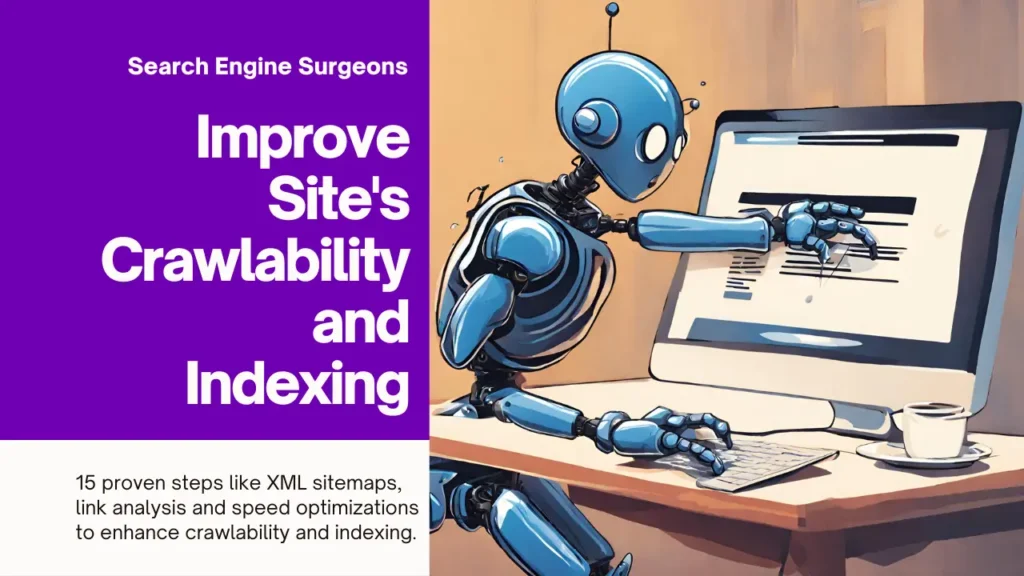We’ve all been there – you spend hours optimizing your website for search engines only to see little to no improvement in your rankings. Frustrated, you start digging deeper to try and uncover what technical issues could be holding you back.
More often than not, the culprit lies in one of the common technical SEO mistakes that seem to plague even experienced marketers. Things like slow page speeds, broken links, duplicate content issues and missing metadata can silently sabotage your search engine optimization efforts.
In this article, I’ll walk through 10 of the most widespread technical SEO issues that I’ve encountered in my work helping businesses improve their search visibility. For each one, I’ll explain how to check if it’s affecting your site, and more importantly, how to fix it.
Slow Page Speed
We’ve all been there – you load up your website, only to stare impatiently at the spinning wheel as it struggles to display. Slow page speeds are frustrating for users and search engines. Google has openly stated that speed is a direct ranking factor, so fixing this issue should be a top priority.
How to Check Page Speed
The easiest way to check your site speed is to use Google’s free PageSpeed Insights tool. Pop your URL in and it will run a analysis and give you scores for desktop and mobile. Some other options include Pingdom, GTmetrix and the Lighthouse extension if you use Chrome.
When I first started optimizing sites years ago, one of my clients was scoring an abysmal 13/100 on PageSpeed Insights. Talk about painfully slow! Through trial and error, we were eventually able to boost it up to 90. Here are some of the key things we focused on:
Ways to Improve Page Speed
- Minify assets: This means compressing things like CSS, JavaScript and HTML to reduce file sizes. We were able to save over 50% on initial payload just by minifying.
- Lazy load images: Only load images below the fold once the user scrolls to them. This stopped everything from loading at once.
- Enable browser caching: Leverage caching headers so users aren’t re-downloading assets repeatedly on every page load.
- Use a CDN: Content delivery networks store static assets closer to users worldwide, cutting down fetch times significantly.
- Reduce redirects: Every additional HTTP request adds to load time. We eliminated unnecessary redirects in the process.
- Compress images: Tools like TinyPNG and ImageOptim can reduce image file sizes without noticeable quality loss.
Making these relatively simple optimizations took the client from a sluggish experience to a lightening fast one. Speed is so important for the user experience and SEO – I’d encourage taking the time to analyze and improve it wherever possible.
Broken Links
Ever click a link on a website only to get a 404 error? Broken links are frustrating for users and can seriously damage your SEO. After all, every dead end is a lost opportunity for Google to properly index your site.
Fixing broken links is important, but finding them can sometimes feel like a wild goose chase. Let me tell you about a funny experience I once had trying to track down an elusive broken link…
How to Find Broken Links
A few years ago, a client asked me to audit their site for broken links. Easy enough task, or so I thought! I started systematically clicking every link with a tool to record any 404s.
Hours passed as I clicked, and clicked, and clicked… growing more puzzled by the lack of any broken links. Then suddenly, at the very bottom of page 57, it happened – a glorious 404!
Elated, I emailed the client… only to get a confused response. They re-checked and said no broken links existed! What?! Back to the drawing board.
After some debugging, I discovered the issue – my tool was not properly handling redirects. So some “broken” links were actually redirecting without me realizing.
The moral? Don’t rely on just one method. Some great free tools include Xenu’s Link Sleuth and Screaming Frog can also help. And don’t rule out user error!
How to Fix Broken Links
Once you’ve identified broken links, fixing them is straightforward:
- Remove or replace links that point to non-existing pages
- Ensure redirects are set up for moved pages
- Check for typos or minor URL issues
- Use the rel=”canonical” tag for duplicate pages
- Make sure internal links work as intended
Regular link audits can help prevent broken links from piling up. A small broken link cleanup effort can go a long way for SEO and the user experience.
Duplicate Content
Have you ever rewritten an article to target different keywords, only to end up confusing Google with near-identical pages? Duplicate content is a common issue many site owners struggle with.
As someone who has made this mistake more times than I’d like to admit, let me share a funny story…
What is Duplicate Content?
In my early SEO days, I decided the best way to rank multiple pages was to just tweak one article for various long-tail keywords. So I created:
- “5 Tips for Online Business Success”
- “5 Strategies for Online Business Owners”
- “5 Ways to Achieve Online Business Goals”
You get the idea… same content, different titles. Google was not amused! I quickly learned that duplicate content is a big no-no.
So in simple terms, duplicate content refers to substantive blocks of text that are either completely identical or very similar across pages on your site or the web.
Ways to Avoid Duplicate Content
Here are some best practices I now follow to prevent duplicate content issues:
- Create truly unique pages tailored for each keyword
- Vary content with different examples, statistics, or perspectives
- Leverage user-generated content like comments or reviews
- Add a canonical tag for similar pages on your domain
- Remove or consolidate near-duplicate pages
- Leverage syndication techniques like RSS feeds carefully
The moral of the story? Don’t be lazy with content – put in the effort to craft truly unique pages and avoid duplicate content headaches down the road.
Mobile Usability Issues
In today’s world, good mobile experiences are table stakes. After all, over half of all web traffic now comes from smartphones. But optimizing for tiny screens isn’t always intuitive.
Common Mobile Usability Errors
When I first launched my personal site years ago, I foolishly designed it only for desktop. On mobile, the text was tiny and overlapped. Scrolling was a nightmare too.
One day, I shared the site with a friend – on his phone. The confused look and prolonged silence said it all! He eventually said, “this is unreadable dude.” Yup, major mobile fail.
Some other common errors include:
- Fonts too small to read
- Tapping targets too close together
- Slow load times over cellular networks
- Lack of responsive design/images
- Not optimizing for touch screens
Ensuring a Good Mobile Experience
To avoid scaring off mobile users, focus on:
- Responsive design using media queries
- Large touch targets and simple navigation
- Optimized images for different screen densities
- Fast load times (2 secs max recommended)
- Custom 404 pages for non-mobile optimized content
- Testing across different devices/screen sizes
The lesson? Don’t neglect mobile, or you may end up the butt of some teasing from your friends!
Missing Meta Descriptions
You’ve heard of meta descriptions, but do you actually use them on your site? They play an important role for SEO and usability, so don’t overlook this often-missed opportunity.
The Importance of Meta Descriptions
Meta descriptions provide a snippet of text that displays below the clickable title on SERPs. They’re designed to give users a quick summary of your page content to help them decide if they want to click.
Did you know that meta descriptions are not the direct factor into Google’s ranking algorithm, But it will still help you with your SEO? Descriptions that accurately represent content and motivate clicks will help your rankings.
A Lesson in Descriptions
When I first started my blog, I neglected meta descriptions completely. My SERP snippets looked bare and unappealing as a result.
One day, a friend took a look at my site in Google and said “these results don’t make me want to click at all.” Ouch, he was right. I was missing out on clicks and rankings by not optimizing descriptions.
Best Practices for Meta Descriptions
Here are some tips I’ve learned for effective meta descriptions:
- Keep them under 155 characters for full display
- Include your target keyword for relevancy
- Write benefits-focused, clickbait-style text
- Accurately represent the actual page content
- Test different descriptions to maximize CTR
- Use the description field in search console
By adding optimized descriptions, I saw my click-through rates increase by 15%! Don’t miss this easy win.
HTTPS Issues
Once upon a time, plain old HTTP was the standard for websites. But in today’s world of increased security risks, having HTTPS has become table stakes. However, many sites still haven’t made the switch.
Benefits of HTTPS
HTTPS provides crucial security and privacy benefits compared to HTTP. Some key advantages include:
- Protection from man-in-the-middle attacks
- Encryption of data in transit
- Increased user trust and engagement
- Better SEO – Google rewards HTTPS implementations
Did you know Google also now marks HTTP sites as “not secure”? That warning label can’t be good for usability or conversions.
How to Implement HTTPS
Luckily, enabling HTTPS is simpler than ever:
- Get a free SSL certificate from Let’s Encrypt
- Install it in your web server (e.g. Apache)
- Configure your site’s base URL to be HTTPS
- Redirect all HTTP traffic to HTTPS
- Fix mixed content issues
It may require some configuration, but the long-term benefits far outweigh the short-term work. Moral of the story? Make the switch to HTTPS ASAP if you haven’t already. Your users and search engine rankings will thank you!
XML Sitemap Errors
Sitemaps can be tricky to get right. While they’re meant to help search engines discover your content, sitemaps riddled with errors may do more harm than good. Let’s look at some common issues.
Common Sitemap Errors
- Outdated URLs that now return 404s
- Duplicate URLs included in the sitemap
- URLs missing important parameters like ?page=2
- Filesize too large (over 50MB)
- Incorrect XML formatting
- Not submitting the sitemap to Google Search Console
When I first created a sitemap for my site years ago, it was a mess! I included every URL regardless of indexing rules. No wonder Google couldn’t make sense of it.
Best Practices for XML Sitemaps
To avoid common mistakes:
- Only include pages you want indexed
- Remove outdated/deleted pages
- Add new/updated pages frequently
- Compress large sitemaps into smaller chunks
- Validate sitemap against XML schema
- Submit to Google Search Console monthly
- Check for errors reported in Search Console
Following these guidelines ensures your sitemap actually helps search engines rather than hindering them. Don’t learn this lesson the hard way – create sitemaps with care.
Redirect Issues
Redirects are an important part of any website – they help guide users and search engines to updated URLs. However, broken redirects can negatively impact the user experience and search engine optimization.
Types of Redirect Issues
- Broken 301/302 redirects
- Redirect chains (multiple redirects to reach a page)
- Redirects from www to non-www or vice versa
- Redirecting the home page
- Redirecting canonical URLs
In the past, I’ve encountered all sorts of bizarre redirect issues. One site had over 10 redirects for the homepage! No wonder it was ranking poorly.
How to Check for Redirect Issues
To diagnose potential problems:
- Audit redirects with the ‘Redirect Path’ tool in Google Search Console
- Use the ‘Fetch as Google’ tool to crawl URLs
- Check for redirect status codes e.g. 301, 302
- Inspect network requests in browser dev tools
- Search in Google for site:example.com to catch non-canonical URLs
Once identified, problematic redirects should be fixed – often a simple server configuration issue. Clean redirects are important for seamless user experiences across links and search engines.
Schema Markup Errors
Schema markup is a powerful way to provide structured data about your web pages to search engines and other applications. However, adding schema incorrectly can sometimes do more harm than good.
Using Schema Markup Correctly
When I first started using schema on my site, I’ll admit my implementation was sloppy. I didn’t fully understand the guidelines.
To implement schema correctly:
- Only use applicable schema types for your content
- Provide all required properties for each type
- Use proper formatting for dates, prices etc.
- Nest schemas where relevant (e.g. Article > Author)
- Validate schema with Google’s testing tool
Common Schema Markup Mistakes
Some issues I’ve seen include:
- Invalid JSON-LD syntax
- Missing @type property
- Incorrect or invalid property values
- Overuse of less relevant schemas
- Duplicate/conflicting schemas on a page
- Outdated schema that doesn’t match content
The consequences of flawed schema can confuse bots and possibly get your content excluded from features like Knowledge Panels. Take the time to learn schema and implement it properly.
More to Focus
While this article covered some of the most common technical SEO issues, the list goes beyond just these topics. A few other areas worth evaluating include:
- Site Architecture – Ensure logical URL structures, internal linking and that all pages can be easily discovered by search engines.
- JavaScript Errors – JavaScript issues can negatively impact usability and search engine rendering. Use developer tools to debug and fix JS errors.
- Outdated Plugins/Theme – Old themes and plugins may contain bugs or security vulnerabilities. Keep software up-to-date.
- Broken Images/Media – Missing or inaccessible images, videos and other media result in poor user experience. Audit and fix or remove broken assets.
- Excessive Redirects – Avoid redirect chains that could confuse bots and users. Keep redirects as streamlined as possible.
- Cross-Domain Issues – If using multiple domains/sites, make sure interlinking and cross-linking is properly configured.
With ongoing monitoring and maintenance, even more minor technical problems can be identified and addressed before they impact search visibility or user satisfaction. Maintaining technical SEO best practices should remain a long-term focus.
Conclusion
While technical SEO issues can be frustrating to uncover and resolve, taking the time to address them is crucial for search engine optimization success. An optimized site that runs smoothly, has clean code and is properly structured will lead to happier users and search engines alike.
The tips covered here on page speed, redirects, schema implementation and more provide a good starting point for evaluating any technical issues currently holding a site back. With diligent auditing and incremental improvements over time, websites can eliminate many common problems that inadvertently undermine their SEO.
Most importantly, keep the user experience top of mind. Technical optimizations should enhance how people interact with and consume content. By focusing on both technical excellence and user-centric best practices, websites can build a strong foundation for organic search visibility.





